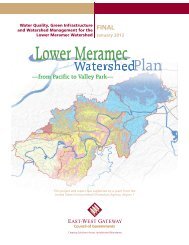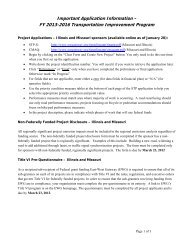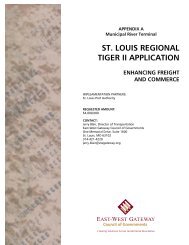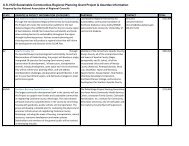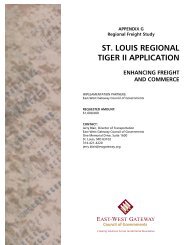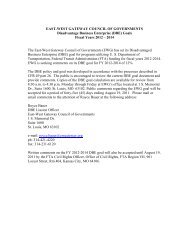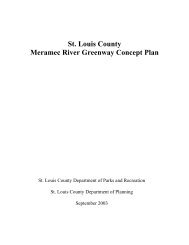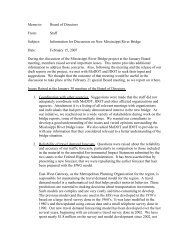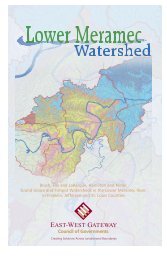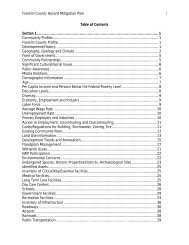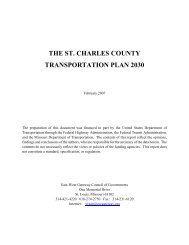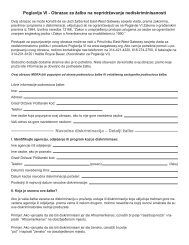Jefferson County - East-West Gateway Coordinating Council
Jefferson County - East-West Gateway Coordinating Council
Jefferson County - East-West Gateway Coordinating Council
You also want an ePaper? Increase the reach of your titles
YUMPU automatically turns print PDFs into web optimized ePapers that Google loves.
86<br />
<strong>Jefferson</strong> <strong>County</strong> – Section 2<br />
According to the WPA, three-fifths of all first-time rural relief cases in the Great Plains area<br />
were directly related to drought, with a disproportionate amount of cases being farmers<br />
(68%) and especially tenant farmers (70% of the 68%). However, it is not known how<br />
many of the remaining cases (32%) were indirectly affected by drought. The WPA report<br />
also noted that 21% of all rural families in the Great Plains area were receiving federal<br />
emergency relief by 1936 (Link et al., 1937); the number was as high as 90% in hard-hit<br />
counties (Warrick, 1980). Thus, even though the exact economic losses are not known for<br />
this time period, they were substantial enough to cause widespread economic disruption<br />
that affected the entire nation.<br />
The Palmer Drought Severity Index relates climate and weather to prolonged and abnormal<br />
soil moisture deficiencies affecting water sensitive economies in the US. The index is useful<br />
in delineating disaster areas and indicating the availability of irrigation water supplies,<br />
reservoir levels, range conditions, amount of stock water, and potential intensity of forest<br />
fires.<br />
Seasonal Pattern<br />
Based on Table J45 above from Regions 2 and 5, a trend emerges of mild drought<br />
occurring from January through May from the period of record from 1895 to 1995.<br />
Speed of Onset And/Or Existing Warning Systems<br />
By nature, drought occurs very slowly. Existing warning systems have been developed by<br />
Missouri Department of Natural Resources (Missouri Drought Response Plan). Mr. Steve A.<br />
McIntosh is the contact person for drought in Missouri. The function of the plan is to assist<br />
in the response, monitoring and prediction, communication, and planning in the event of a<br />
drought. The plan provides for operations and administrative procedures that activate the<br />
Drought Assessment Committee, Impact Task Forces, Governor's Drought Executive<br />
Committee, and the State Emergency Operations Center. The Governor's declaration<br />
empowers state agencies to implement water shortage emergency actions. The statute or<br />
authority that regulates this activity is the State Water Resources Plan (Revised statutes of<br />
Missouri Chapters 640.415). The primary agencies involved in drought activities include:<br />
Missouri Dept. of Natural Resources (primary), Missouri Dept. of Agriculture, Missouri Dept.<br />
of Public Safety, Missouri Dept. of Conservation, Missouri Dept. of Social Services,<br />
University of Missouri-Columbia, DOC, USDA, US Army, DOI, EPA, and FEMA. The drought<br />
plan serves the following groups: water supply systems of individual ranchers and farmers,<br />
local governments, federal agencies, domestic water users, health care facilities, public uses<br />
such as electric power generation, firefighting, key military facilities, communications, and<br />
wastewater systems.<br />
As a part of the plan, monthly drought monitoring (consisting of water monitoring data<br />
and weather data) is provided to the State Emergency Management Agency by the<br />
Department of Natural Resources and the National Weather Service. MDNR utilizes the<br />
Palmer Drought Index as a trigger to determine drought phases and actions to be taken.



